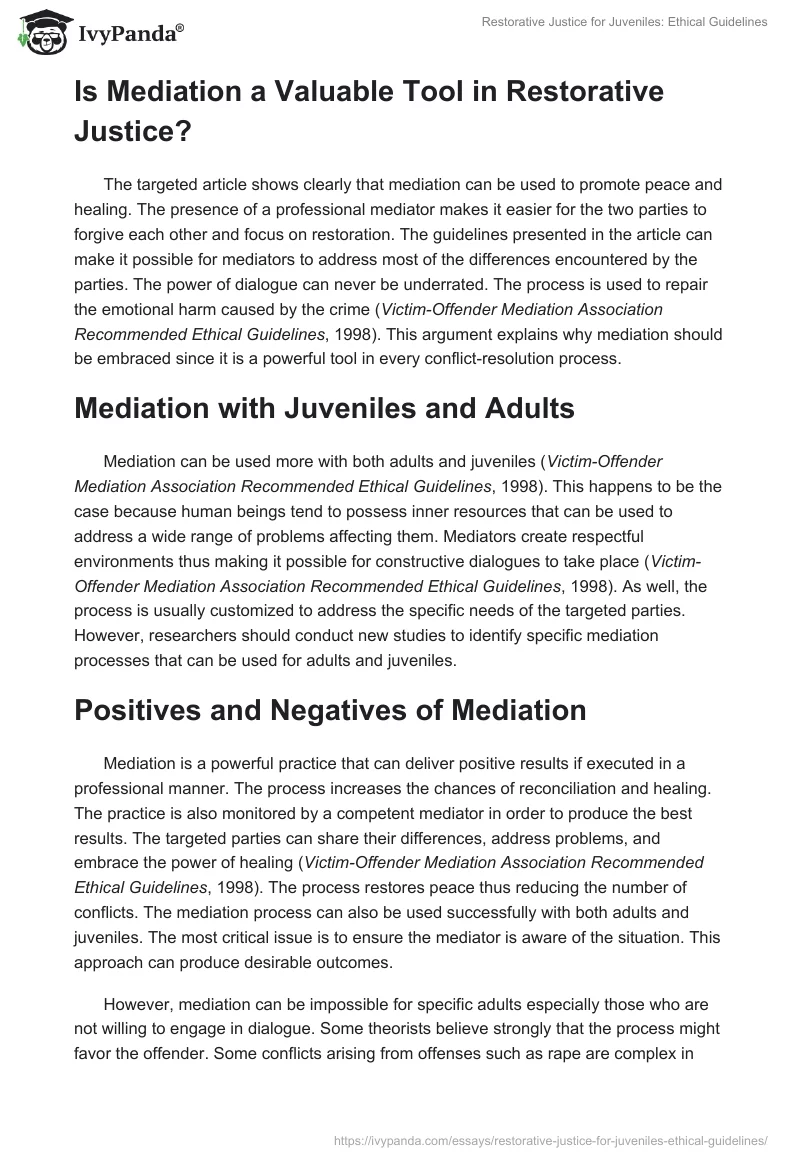Article Summary
The article “Victim-Offender Mediation Association Recommended Ethical Guidelines” offers powerful ethical guidelines for effective victim-offender mediation. Offenders and their victims can be assisted by mediators in order “to promote the level of restoration and healing” (Victim-Offender Mediation Association Recommended Ethical Guidelines, 1998, para. 1). Mediators offer inspiration, information, mentorship, and leadership in order to create the most appropriate opportunities for effective dialogue (Victim-Offender Mediation Association Recommended Ethical Guidelines, 1998). This process can effectively address every injury associated with the targeted offense. Mediators should ensure every dialogue is carefully supported using the most appropriate concepts and practices. The ultimate goal is to establish a respectful environment for dialogue. Mediators guide the parties and identify the major guidelines that can make the process more meaningful.
Mediators should be ready to use transformative approaches. They should encourage the players to exercise their rights and acquire the most appropriate resources. Follow-ups are critical after every mediation practice. As well, mediators should establish positive relationships with the participants. They should embrace powerful concepts such as impartiality, confidentiality, and openness. Circumstances “capable of causing conflicts of interest should also be disclosed” (Victim-Offender Mediation Association Recommended Ethical Guidelines, 1998, para. 35). It is also relevant to disclose necessary information to the two parties. The mediators should provide the most appropriate information and advice to the players. They should also ensure the final agreement is formalized and implemented. The discussions should not be prolonged after the individuals reach a final impasse (Victim-Offender Mediation Association Recommended Ethical Guidelines, 1998). Mediators should have the relevant training. The article also outlines the major ethical concerns that should be taken seriously. Such concerns include disclosure of mediation fees in advance. They should cultivate positive relationships with other mediators.
Is Mediation a Valuable Tool in Restorative Justice?
The targeted article shows clearly that mediation can be used to promote peace and healing. The presence of a professional mediator makes it easier for the two parties to forgive each other and focus on restoration. The guidelines presented in the article can make it possible for mediators to address most of the differences encountered by the parties. The power of dialogue can never be underrated. The process is used to repair the emotional harm caused by the crime (Victim-Offender Mediation Association Recommended Ethical Guidelines, 1998). This argument explains why mediation should be embraced since it is a powerful tool in every conflict-resolution process.
Mediation with Juveniles and Adults
Mediation can be used more with both adults and juveniles (Victim-Offender Mediation Association Recommended Ethical Guidelines, 1998). This happens to be the case because human beings tend to possess inner resources that can be used to address a wide range of problems affecting them. Mediators create respectful environments thus making it possible for constructive dialogues to take place (Victim-Offender Mediation Association Recommended Ethical Guidelines, 1998). As well, the process is usually customized to address the specific needs of the targeted parties. However, researchers should conduct new studies to identify specific mediation processes that can be used for adults and juveniles.
Positives and Negatives of Mediation
Mediation is a powerful practice that can deliver positive results if executed in a professional manner. The process increases the chances of reconciliation and healing. The practice is also monitored by a competent mediator in order to produce the best results. The targeted parties can share their differences, address problems, and embrace the power of healing (Victim-Offender Mediation Association Recommended Ethical Guidelines, 1998). The process restores peace thus reducing the number of conflicts. The mediation process can also be used successfully with both adults and juveniles. The most critical issue is to ensure the mediator is aware of the situation. This approach can produce desirable outcomes.
However, mediation can be impossible for specific adults especially those who are not willing to engage in dialogue. Some theorists believe strongly that the process might favor the offender. Some conflicts arising from offenses such as rape are complex in nature and might not benefit from mediation. Some mediators might be biased thus affecting the entire process. The mediation procedure can also be complex, time-consuming, and degrading (Victim-Offender Mediation Association Recommended Ethical Guidelines, 1998).
Personal Opinion about the Use of Mediation for Juvenile Offenders and their Victims
Mediation is widely used for adults in order to achieve positive results within the shortest time possible. Juvenile offenders should also be given the opportunity to establish new relationships with their respective victims. That being the case, professionals who want to use mediation for juveniles should be aware of the issues affecting such individuals. They should inform their guardians to ensure the process is successful. The highest level of confidentiality should also be maintained to empower such juveniles. Mediation for juveniles is something that can produce positive results whenever executed in a civilized manner (Victim-Offender Mediation Association Recommended Ethical Guidelines, 1998). The presence of the children’s parents of guardians will improve the level of safety. The participants will be ready to engage in meaningful conversations and eventually come up with the best solutions. This strategy can therefore be therapeutic and successful.
Reference
Victim-Offender Mediation Association Recommended Ethical Guidelines. (1998).


